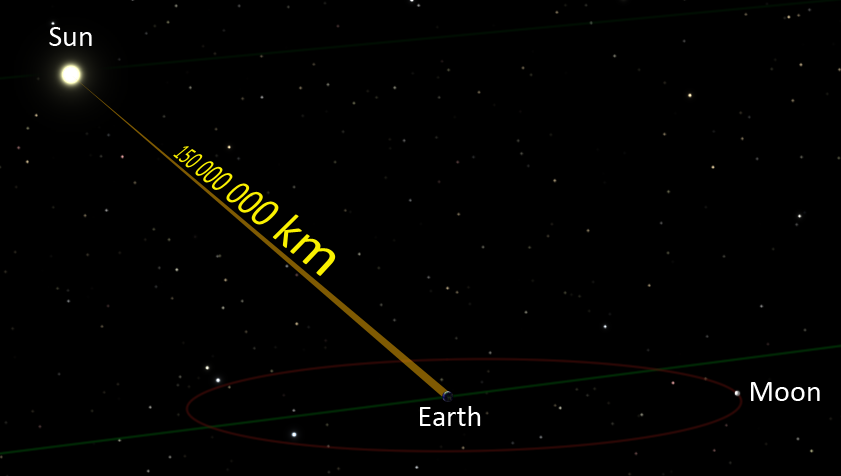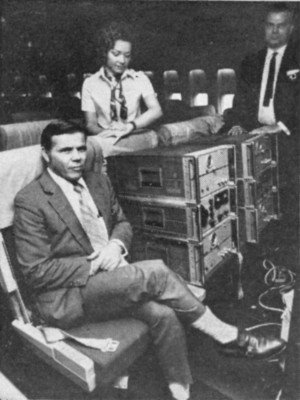
The speed of light is problematic.
Discretely, it's problematic for me and you, right now. Last time, I promised I would talk today about wormholes and warp drives. But, as I was typing up the post, I ran into a problem: How could I talk about going faster than the speed of light if I hadn't even explained the significance of the speed of light?
More broadly, the speed of light is problematic if we want to get somewhere far away really fast, because nothing can go faster than the speed of light.
Let's really hammer that one home.
Nothing Can Move Faster Than Light

This is the amount of time it takes for light from earth to reach the moon
Light moves at a speed represented in physics by the letter "c" - and considered a universal constant.
c = 299 792 458 meters/sec OR 186, 282 miles per second, for fellow Americans.
That number is tough to imagine. Let's try anyway. Imagine closing your eyes, counting to 2, and then opening them on the moon. How was that?
We are trapped behind the speed of light and cannot move faster. The question is how do we know that we're trapped?

This graph roughly illlustrates the growth of a thing called the Lorentz Factor.
Here's how you read this chart. The x-axis is velocity. It goes from 0, through c/2, up to c. Remember c = The Speed Of Light
The y-axis is the Lorentz Factor. Here's the formula to calculate it:

But don't worry about that for now - here's what you need to know:
As you travel faster and faster through spacetime, your body gains energy and time passes slower and slower relative to the passage of time on earth.
The Lorentz Factor is used to calculate just HOW MUCH those, and other things, happen.
Edit #1
@lemouth points out in the comments that the original version of this article made a common mistake in that I conflated mass with 'inertial mass'. Your mass, or "resting mass", is a set number. If you weigh 100 pounds at rest, then you continue to weigh 100 pounds when you're moving at near the speed of light.
What changes as you speed up towards lightspeed is not your mass, but your "inertial mass". This is just another way of saying that as you are sped up towards the speed of light, the overall energy you have is increasing .
Consider it this way:
You weigh 100 pounds. You run head first into your front door at about 8 miles per hour. You slam you head on the door and fall to the ground. You gained some tiny amount of inertial mass in running toward the door, but not enough energy to do any damage. You always had a mass of 100 pounds.
You weigh 100 pounds. You strap a rocket to your back and slam into your front door at 50,000 miles per hour. You and your door. and maybe your neighbors, are vaporized. **You still have a mass of 100 pounds, even though your inertial mass was gigantic.
Get the difference? Going forward, we'll only measure the effects moving towards the speed of light has on time, because I think the effects on inertial mass are a bit more confusing than helpful. Needless to say though, the faster you get, the more inertial mass (energy) your body has. For more on the distinction between resting and inertial mass click this link.

This is a pug with a rocket attached to its back.
I swiped this image from a random dog costume website, as I have neither a rocket, nor a dog.
For the sake of argument lets say that rocket on that pug can accelerate up to the speed of light, carrying the pug with it at the same speed.
c = the speed of light = 670,616,629 miles per hour
Let's see what happens to the pug as it accelerates up to light speed. The Lorentz Factor is commonly abbreviated as "y", which I will use from now on.
- The pug is standing still before blast off:
y = 1
The pug isn't moving at all so there is no change to the normal flow of time
- The rocket fires off at 20,000 miles per hour:
y = 1.0000000004447147
The pug is flying through the air faster than any pug in history. Yet, 20,000 mph is really slow compared to light, so although time moves slower, it's only a tiny bit slower.
But, let's say this wasn't a pug, but a highly accurate satellite travelling in orbit. Believe it or not, even the tiny difference in the value of y - the slightly slower passage of time - has to be calculated for every satellite in space, or they wouldn't work!
- The rocket gets up to 590,000,000 miler per hour:
y = 2.1035963900386907
Now some weird stuff is starting to happen to the pug. As he is approaching the speed of light, y is increasing - at roughly 2.1, every minute the pug flies at this speed - 2.1 minutes will pass back on earth. You see where this is going?
- The rocket gets up to 660,000,000 miles per hour:
y = 5.6419622162940195
The pug is long since dead for a variety of reasons and every minute is now worth over 5 minutes at home.
- The rocket gets up to 670,616,627 mile per hour, one mph slower than light.
y = 12346.68317934842
Every minute the dead pug travels at this speed, over 8 days passes on earth.
Let's take a look at that graph again.

See how the blue line shoots up at the end of x-axis?
As you accelerate towards the speed of light, y increases faster and faster, until you reach the speed of light ... and then ...
y increases infinitely because you can never make it to the speed of light. If you did, y would be an infinite number, you would have an infinite inertial mass (energy) and time would move infinitely slowly - which is to say - time would STOP.
And what if you somehow do make it past that barrier and go faster than light? Well, go plug the number into that equation up there and find out. Hint - things don't work out.
How do we know all of this? Einstein did a lot of math to show it was true in Special Relativity. But how do we really know the Lorentz Factor exists at all? After all, we've never shot a pug on a rocket at near the speed of light.
True, but these guys did something a lot less messy

The men in this picture are Joseph Hafele and Richard E. Keating
In 1971 these two guys took five super accurate atomic clocks. One clock they left stationary. The other four clocks they took on a world tour, flying around the world twice, once eastward with two of the clocks, and then westward with the other two.
Then they took the clocks they traveled with back to the stationary clock.
And, what do you think they saw?
The time of each of the clocks that travelled was off in relation to the stationary clock by exactly the amount predicted by the Lorentz Factor equation above.
Einstein was right, the Lorentz Factor is real, the speed of light is the fastest anything in spacetime can move, and the universe is a strange, strange place.
Next time, finally, worm holes.
Picture Sources: 1,2,3 and 5, 4, 6
Information Sources:
https://en.wikipedia.org/wiki/Speed_of_light#Upper_limit_on_speeds
https://en.wikipedia.org/wiki/Lorentz_factor
https://cosmosmagazine.com/physics/why-can-t-anything-travel-faster-light
http://www.1728.org/reltivty.htm?b0=155555
